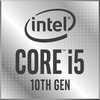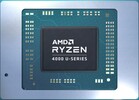Intel Core i7-1068G7 vs AMD Ryzen 5 4680U vs Intel Core i5-1035G4
Intel Core i7-1068G7
► remove from comparison
The Intel Core i7-1068G7 is a quad-core SoC for laptops and Ultrabooks based on the Ice-Lake-U generation that was announced in Mai 2019 (Computex). It integrates four Sunnycove processor cores (8 threads thanks to HyperThreading) clocked at 2.3 (base) - 4.1 (single core Turbo) GHz. All four cores can run at up to 3.6 GHz using Turbo Boost. According to Intel the Sunnycove cores achieve 18% more IPCs (Instructions per Clock) and therefore the CPU performance should be similar to the higher clocked Whiskey-Lake and Coffee-Lake predecessors (e.g. Core i7-8559U, 2.7 - 4.5 GHz). The Core i7-1068G7 is the fastest and only 28 Watt Ice Lake-U chip at the time of announcement in 2019.
The biggest improvement for Ice-Lake is the integrated Gen 11 graphics card called Iris Plus Graphics. The Core i7-1065G7 integrates the biggest G7 variant with 64 CUs clocked at 300 - 1100 MHz. The Iris Plus G7 should be twice as fast as the predecessors and best the AMD Vega 10 GPU in current Ryzen APUs.
Other improvements for Ice Lake are the AI hardware acceleration and the partial integration of Thunderbolt and Wifi 6 in the chip. The integrated DDR4 memory controller supports modules with up to 3200 MHz (and LPDDDR4 3733).
The Core i7-1068G7 is produced in the new 10nm process at Intel that should offer a comparable performance to the 7nm process at TSMC. The TDP is specified at 28 Watts and therefore the CPU is best used in small multimedia laptops from 13-inch upwards (e.g. like a MacBook Pro 13).
AMD Ryzen 5 4680U
► remove from comparison
The AMD Ryzen 5 4680U is a semi-custom APU of the Renoir family designed for Microsoft devices. The 4680U integrates six CPU cores based on the Zen 2 microarchitecture clocked at 2.2 GHz (base) to 4 GHz (Boost) with SMT support for a total 12 threads. The two advantages a 4680U has over the older Ryzen 5 4600U are its higher base clock speed and a faster iGPU.
Architecture
The chip is manufactured on the modern 7 nm TSMC process and in part thanks to this fact, AMD advertises a 2x performance per watt improvement over the 12 nm Ryzen 3000 mobile processors. The built-in dual-channel memory controller supports LPDDR4-4266 RAM. Furthermore, 8 MB of L3 cache can be found on the chip.
Just like the other mobile Ryzen 4000 CPUs, a 4680U supports PCI-Express 3.0. Please go to our Renoir processor hub page for additional information on the product family.
Performance
Multi-thread performance is most comparable to the Ryzen 7 4700U and the Core i5-10500H, the latter being a much more power-hungry chip. This makes the Ryzen a more than decent CPU for most tasks, as of early 2022.
Graphics
In addition to the six CPU cores, the APU also integrates a DX 12 compatible Radeon RX Vega 7 graphics adapter with 7 CUs (448 unified shaders) at up to 1,500 MHz. The Vega iGPU will have no trouble HW-decoding AVC, HEVC and VP9 videos, but the newer AV1 codec will only be decoded via software. In terms of gaming, we are looking at an MX150-level performance. Pretty much all games released in 2020 can be played on low to medium settings in 720p on this graphics adapter.
Power consumption
This Ryzen 5 series chip has a default TDP (also known as the long-term power limit) of 15 W, a value that laptop makers - Microsoft, in this case - are free to change to anything between 10 W and 25 W, with clock speeds and performance changing accordingly as a result. Indeed, we saw the CPU consume roughly 23 watts when subjected to our usual stress testing routine.
The 7 nm TSMC process this Ryzen is built with makes for very decent, as of mid 2022, energy efficiency.
Intel Core i5-1035G4
► remove from comparison
The Intel Core i5-1035G4 is a low-power, Ice Lake family processor (SoC) featuring 4 cores, 8 threads, 6 MB of L3 cache and the Iris Plus G4 (48 EUs) iGPU. It saw the light of day in H2 2019. The chip is designed for use in highly portable laptops; its CPU cores run at 1.1 GHz to 3.7 GHz, with only 3.3 GHz achievable if all the cores are loaded.
Unlike the costlier Core i5-1035G7, the 1035G4 has the 48 EU Intel iGPU at its disposal as opposed to the more powerful Iris Plus G7 (64 EUs); CPU cores have a slightly lower base clock speed in the case of the 1035G4, too.
Architecture & Features
Ice Lake family chips are powered by Sunny Cove CPU cores.The latter aim to do what Palm Cove cores (that we never really got a chance to get a taste of) were expected to do, delivering a double-digit IPC uplift over the venerable Skylake architecture thanks to a range of small improvements across the board including scheduler improvements, larger caches and buffers, and support for new instruction sets.
Thunderbolt 3 support is built right into the Core i5 (meaning the latter has several PCIe 3 lanes exclusive to Thunderbolt devices, reducing the number of additional components required for Thunderbolt to work) and so is CNVi Wi-Fi 6 support (making it easier for Intel to sell its proprietary WLAN cards to laptop makers). The Core i5-1035G4 also has the DL Boost and GNA features for applications centered around machine learning.
The 4 GT/s bus is indicative of a consumer-grade chip, since CPUs for gaming laptops and portable workstations usually employ the faster 8 GT/s bus. RAM support is nothing to sneeze at, at up to DDR4-3200 or LPDDR4-3733. NVMe SSDs are supported, with data transfer rates limited to 3.9 GB/s (this is what four PCIe 3 lanes are good for). SATA drives and even eMMC chips are also natively supported here.
This is not a user-replaceable CPU, as it gets permanently soldered to the motherboard (BGA1526 socket interface).
OS support is limited to 64-bit Windows 10 and Windows 11, as well as many Linux distros.
Performance
The average 1035G4 in our database is very close to the Ryzen 5 2500U and the Core i5-10310U, as far as multi-thread benchmark scores are concerned. This makes it a mid-range chip, as of late 2021. It can even be used for a bit of gaming if mated to a decent graphics card.
The Acer Spin 3 SP314-54N-56S5 is one of the fastest laptops with this chip that we have tested. Thanks to the power limit 1 of 16.5 W, the Acer can be roughly 30% faster than the slowest system with the 1035G4 we know of, depending on the circumstances.
Graphics
The Iris Plus G4 (48 EUs) runs at up to 1.05 GHz. This is a rather decent iGPU that can be as fast as Nvidia's GeForce MX110 or even MX130, depending on the circumstances. It will handle many games at 1080p or 720p provided one is content with low or medium quality settings, respectively.
This DX12-compatible graphics adapter will drive up to 3 monitors with resolutions as high as 5120 x 3200. There is no support for ray tracing here and no hardware support for the latest AV1 codec; the usual HEVC, AVC and VP9 codecs are supported, thankfully.
Power consumption
This 10th generation Intel Core i5 processor has a default TDP of 15 W (also known as the long-term power limit). Laptop makers are allowed to change that value to anything between 12 W and 25 W, with clock speeds and performance changing accordingly. This means the CPU is too power-hungry to be used as the base of a passively cooled laptop, tablet, mini-PC.
The Core i5-1035G4 is manufactured on Intel's 2nd generation 10 nm process (not "10 nm SuperFin" or "Intel 7") for average energy efficiency, as of early 2023.
| Model | Intel Core i7-1068G7 | AMD Ryzen 5 4680U | Intel Core i5-1035G4 | ||||||||||||||||||||||||||||||||||||||||||||||||||||||||||||
| Series | Intel Ice Lake | AMD Renoir (Ryzen 4000 APU) | Intel Ice Lake | ||||||||||||||||||||||||||||||||||||||||||||||||||||||||||||
| Codename | Ice Lake U | Renoir-U (Zen 2) | Ice Lake-U | ||||||||||||||||||||||||||||||||||||||||||||||||||||||||||||
| Series: Ice Lake Ice Lake-U |
|
|
| ||||||||||||||||||||||||||||||||||||||||||||||||||||||||||||
| Clock | 2300 - 4100 MHz | 2200 - 4000 MHz | 1100 - 3700 MHz | ||||||||||||||||||||||||||||||||||||||||||||||||||||||||||||
| L1 Cache | 192 KB | 384 KB | 192 KB | ||||||||||||||||||||||||||||||||||||||||||||||||||||||||||||
| L2 Cache | 2 MB | 3 MB | 2 MB | ||||||||||||||||||||||||||||||||||||||||||||||||||||||||||||
| L3 Cache | 8 MB | 8 MB | 6 MB | ||||||||||||||||||||||||||||||||||||||||||||||||||||||||||||
| Cores / Threads | 4 / 8 | 6 / 12 | 4 / 8 | ||||||||||||||||||||||||||||||||||||||||||||||||||||||||||||
| TDP | 28 Watt | 15 Watt | 15 Watt | ||||||||||||||||||||||||||||||||||||||||||||||||||||||||||||
| Technology | 10 nm | 7 nm | 10 nm | ||||||||||||||||||||||||||||||||||||||||||||||||||||||||||||
| Features | AVX512, DL Boost, Turbo Boost 2.0 | LPDDR4-4266 RAM, PCIe 3, MMX, SSE, SSE2, SSE3, SSSE3, SSE4A, SSE4.1, SSE4.2, AVX, AVX2, BMI2, ABM, FMA, ADX, SMEP, SMAP, SMT, CPB, AES-NI, RDRAND, RDSEED, SHA | DDR4-3200/LPDDR4-3733 RAM, PCIe 3, 4 GT/s bus, DL Boost, GNA, MMX, SSE, SSE2, SSE3, SSSE3, SSE4.1, SSE4.2, AVX, AVX2, AVX-512, BMI2, ABM, FMA, ADX, VMX, SMEP, SMAP, EIST, TM1, TM2, Hyper-Threading, Turbo, SST, AES-NI, RDRAND, RDSEED, SHA, SGX | ||||||||||||||||||||||||||||||||||||||||||||||||||||||||||||
| iGPU | Intel Iris Plus Graphics G7 (Ice Lake 64 EU) (300 - 1100 MHz) | AMD Radeon RX Vega 7 ( - 1500 MHz) | Intel Iris Plus Graphics G4 (Ice Lake 48 EU) (300 - 1050 MHz) | ||||||||||||||||||||||||||||||||||||||||||||||||||||||||||||
| Architecture | x86 | x86 | x86 | ||||||||||||||||||||||||||||||||||||||||||||||||||||||||||||
| Announced | |||||||||||||||||||||||||||||||||||||||||||||||||||||||||||||||
| max. Temp. | 105 °C | 100 °C | |||||||||||||||||||||||||||||||||||||||||||||||||||||||||||||
| Socket | FP6 | BGA1526 | |||||||||||||||||||||||||||||||||||||||||||||||||||||||||||||
| Manufacturer | www.amd.com | ark.intel.com |


 Deutsch
Deutsch English
English Español
Español Français
Français Italiano
Italiano Nederlands
Nederlands Polski
Polski Português
Português Русский
Русский Türkçe
Türkçe Svenska
Svenska Chinese
Chinese Magyar
Magyar